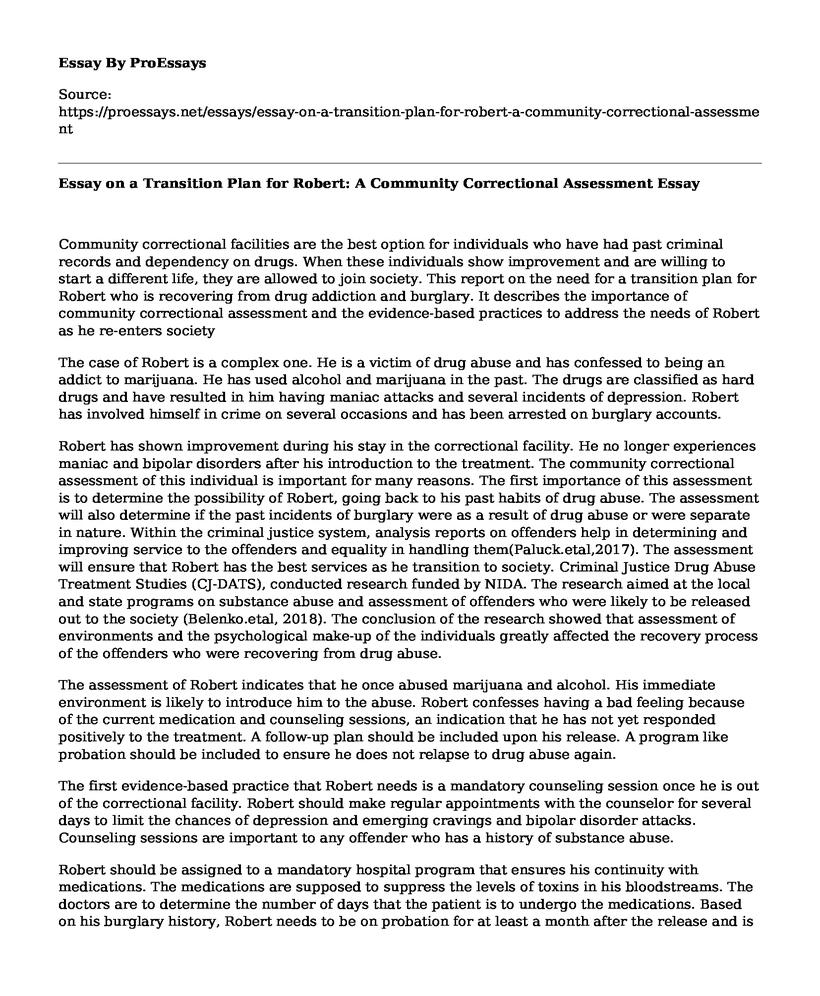Community correctional facilities are the best option for individuals who have had past criminal records and dependency on drugs. When these individuals show improvement and are willing to start a different life, they are allowed to join society. This report on the need for a transition plan for Robert who is recovering from drug addiction and burglary. It describes the importance of community correctional assessment and the evidence-based practices to address the needs of Robert as he re-enters society
The case of Robert is a complex one. He is a victim of drug abuse and has confessed to being an addict to marijuana. He has used alcohol and marijuana in the past. The drugs are classified as hard drugs and have resulted in him having maniac attacks and several incidents of depression. Robert has involved himself in crime on several occasions and has been arrested on burglary accounts.
Robert has shown improvement during his stay in the correctional facility. He no longer experiences maniac and bipolar disorders after his introduction to the treatment. The community correctional assessment of this individual is important for many reasons. The first importance of this assessment is to determine the possibility of Robert, going back to his past habits of drug abuse. The assessment will also determine if the past incidents of burglary were as a result of drug abuse or were separate in nature. Within the criminal justice system, analysis reports on offenders help in determining and improving service to the offenders and equality in handling them(Paluck.etal,2017). The assessment will ensure that Robert has the best services as he transition to society. Criminal Justice Drug Abuse Treatment Studies (CJ-DATS), conducted research funded by NIDA. The research aimed at the local and state programs on substance abuse and assessment of offenders who were likely to be released out to the society (Belenko.etal, 2018). The conclusion of the research showed that assessment of environments and the psychological make-up of the individuals greatly affected the recovery process of the offenders who were recovering from drug abuse.
The assessment of Robert indicates that he once abused marijuana and alcohol. His immediate environment is likely to introduce him to the abuse. Robert confesses having a bad feeling because of the current medication and counseling sessions, an indication that he has not yet responded positively to the treatment. A follow-up plan should be included upon his release. A program like probation should be included to ensure he does not relapse to drug abuse again.
The first evidence-based practice that Robert needs is a mandatory counseling session once he is out of the correctional facility. Robert should make regular appointments with the counselor for several days to limit the chances of depression and emerging cravings and bipolar disorder attacks. Counseling sessions are important to any offender who has a history of substance abuse.
Robert should be assigned to a mandatory hospital program that ensures his continuity with medications. The medications are supposed to suppress the levels of toxins in his bloodstreams. The doctors are to determine the number of days that the patient is to undergo the medications. Based on his burglary history, Robert needs to be on probation for at least a month after the release and is to be actively involved in the community's voluntary activities. He is to report to the nearest police service to be assigned duties every weekend. He is to work without supervision to enhance his ability to make independent choices. Robert should be empowered on the need to make important decisions. The measures that can be applied to reduce the chances of the offender resuming the acts of burglary may involve the need of the offender to learn basic skills such as carpentry, weaving or even baking. The skills can be a source of income for Robert.
Conclusion
In conclusion, the use of community correction has been proved to be more effective than incarceration especially to offenders involved in substance abuse. It reduces recidivism and improves the safety of the public and even the health of the involved persons. Community correction is highly made up of evidence-based practices that are difficult to integrate into the community due to several factors such as cost and, administrative personnel and decisions (Paluck.etal, 2017). There should be a clear model on the implementation of these practices to avoid future inconvenience due to a lack of funds and the necessary skills.
References
Belenko, S., Johnson, I. D., Taxman, F. S., & Rieckmann, T. (2018). Probation staff attitudes toward substance abuse treatment and evidence-based practices. International journal of offender therapy and comparative criminology, 62(2), 313-333.
Paluck, E., Banka, D., McCarron, M. C., & Pandey, M. (2017). Effectiveness of the Dedicated Substance Abuse Treatment Unit in the Regina Correctional Centre: A seven-year retrospective analysis. Journal of Community Safety and Well-Being, 2(3), 91-100.
Cite this page
Essay on a Transition Plan for Robert: A Community Correctional Assessment. (2023, Mar 26). Retrieved from https://proessays.net/essays/essay-on-a-transition-plan-for-robert-a-community-correctional-assessment
If you are the original author of this essay and no longer wish to have it published on the ProEssays website, please click below to request its removal:
- Pop Art Impact to Guns, Violence, Civil Rights and Political Reforms
- Paper Example on Stress
- Essay Sample on Systems Perspective
- Ethical Considerations of Human Cloning Essay Example
- Pros and Cons of Cannabis Legalization in Canada - Essay Sample
- Incarceration in Texas - Essay Sample
- Essay Sample on Diagnosing Mental Disorders: 2 Case Studies







